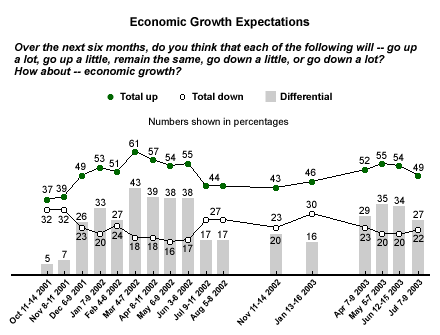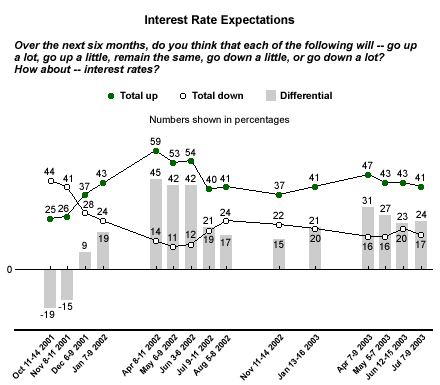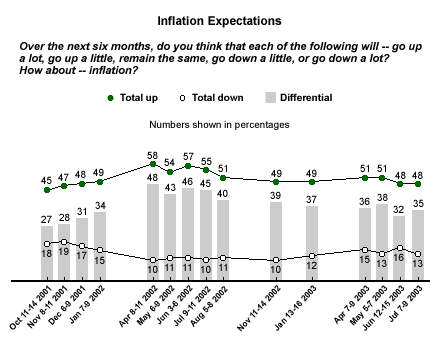In a session with the House Financial Services Committee last week, Federal Reserve Chairman Alan Greenspan optimistically stated that the U.S. economy is "at a turning point," and predicted that low interest rates, increasing stock prices, and the effects of the new tax cut would spur economic growth. On Friday, it was reported that the University of Michigan's preliminary consumer sentiment index rose in early July from its final June reading. Not surprisingly, many analysts noted that the increase was due to the same factors cited by Greenspan earlier in the week.
In sharp contrast, a July 7-9 Gallup Poll* -- as reported last week -- shows just the opposite. The June rise in consumer optimism about the economy did not continue to build in July. The percentage of American consumers rating economic conditions as "good" or "excellent" decreased slightly between June and July, and consumers are slightly more likely to say that economic conditions are getting worse than to say they are getting better. (See "A Turning Point for Consumer Perceptions" in Related Items.) The public gave a similarly tepid response when asked about its expectations for economic growth, interest rates, and inflation over the next six months.
Fewer Consumers Expect Increased Economic Growth
The percentage of consumers expecting economic growth to increase over the next six months declined from 54% in June to 49% in July, while the percentage of those expecting growth to decrease rose from 20% to 22%. Thus, the differential between those expecting an increase in economic growth and those expecting a decrease fell from +34% in June to +27% in July.
Consumer expectations for increasing economic growth are now about where they were in April 2003 (+29 differential). Currently, consumer expectations are much better than they were in January 2003 (+16 differential) and October 2001 (+5 differential), but well below where they were in March 2002 (+43 differential).

Still, Consumers' Interest Rate Expectations Are About the Same…
The percentage of consumers expecting the interest rates to increase over the next six months declined from 43% in June to 41% in July. At the same time, the percentage of consumers expecting rates to go down also declined from 20% in June to 17% in July. So the differential between those expecting rates to go up and those expecting them to go down was virtually unchanged -- +23 in June and +24 in July.
Right now, substantially fewer consumers expect interest rates to increase in the months ahead than was the case in April 2002, when 59% expected rates to increase and the differential was +45. On the other hand, far fewer Americans expect rates to decline now than in October 2001, when 25% expected rates to increase and the differential was -19.

. . . As Are Consumer Inflation Expectations
According to the July poll, 48% of consumers expect inflation to accelerate in the next six months. This percentage is the same as it was in June, although the inflation expectations differential increased from +32 in June to +35 in July. At present, consumer inflation expectations are not as great as they were a year ago when the differential was +45, but the differential is above its October 2001 level of +27.

Consumer Growth Expectations Are Extremely Fragile
The failure of consumer expectations to gain additional positive momentum in July is troubling. As the Fed and the analyst community have argued, fiscal and monetary policies are now highly stimulative. Investors showed great enthusiasm in June -- maybe even a little too much -- and virtually every economic forecaster expects economic growth to improve in the months ahead. Still, contrary to what some observers see in the University of Michigan's preliminary report, Gallup's data does not support the idea that consumers or business decision-makers are convinced, at least at this point.
In essence, recent economic crosscurrents have made today's consumer expectations extremely fragile. The hope is that we are experiencing a lag between the implementation and the positive impact on consumer perceptions of the recent economic stimuli. Tax-cut checks and withholding changes don't even begin to take place until late this month, and lower interest rates can take four to six months to have an impact.
With any luck, consumer optimism -- and even business optimism -- will build in the months ahead and we'll see a surge in consumer/business optimism and a much stronger economy later this year and into 2004. If not, today's economic fragility may well translate into political mayhem as both major parties recognize that next year's elections could be very difficult for many of today's officeholders.
*Results are based on telephone interviews with 1,006 national adults, aged 18 and older, conducted July 7- 9, 2003. For results based on these total samples, one can say with 95% confidence that the margin of sampling error is ±3%.

